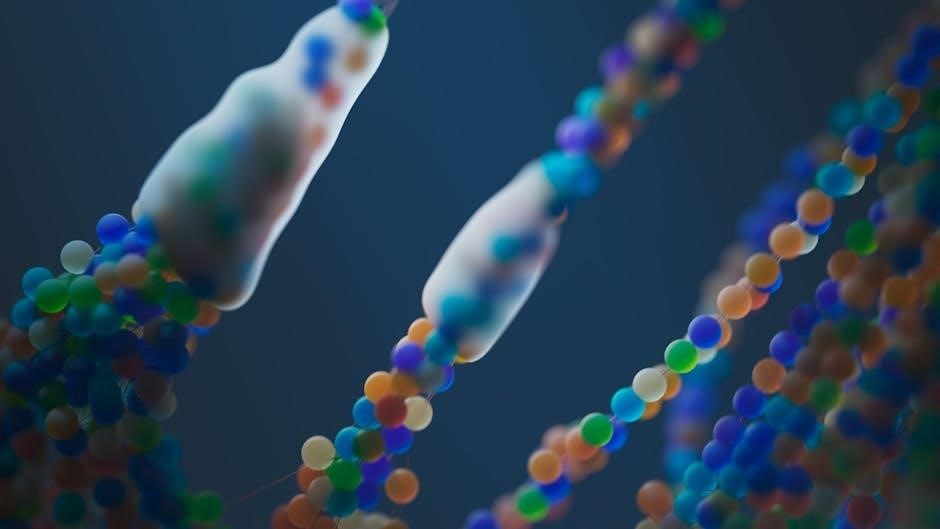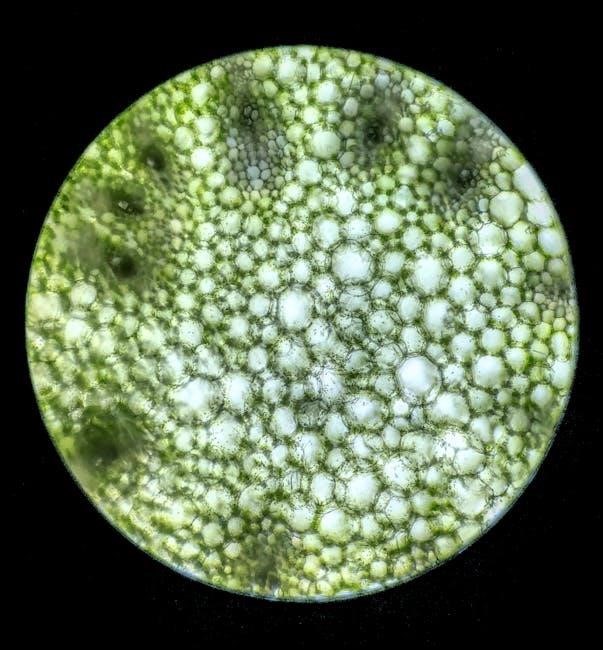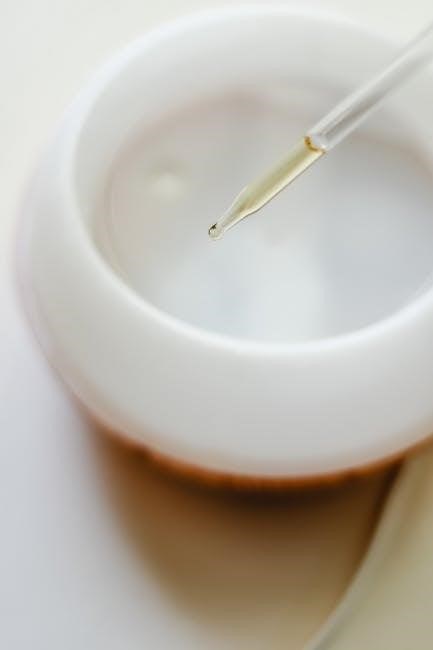The Organic Chem Lab Survival Manual by James W. Zubrick serves as a comprehensive guide for students navigating the challenges of organic chemistry laboratories. It focuses on essential techniques, safety protocols, and practical tips to build confidence and proficiency. Designed for both beginners and experienced learners, the manual emphasizes understanding over memorization, fostering a deeper grasp of lab practices. By prioritizing organization and preparedness, it equips students with the tools to succeed in the dynamic and often demanding environment of organic chemistry labs.

Understanding the Lab Setup
Mastering the lab setup is crucial for success in organic chemistry. Familiarize yourself with the workspace, equipment, and procedures to ensure efficient and safe experimentation from the start.
Essential Equipment for Organic Chemistry Labs
Organic chemistry labs require specific equipment to perform experiments safely and effectively. Key items include round-bottom flasks, condensers, separatory funnels, Erlenmeyer flasks, and volumetric flasks for precise measurements. Heating mantles, hot plates, and cooling baths are used for temperature control during reactions. Glassware like test tubes, beakers, and watch glasses are essential for mixing and observing reactions. Measuring tools such as burettes, pipettes, and syringes are critical for accurate reagent dispensing. Stirring devices, such as magnetic stir bars and overhead stirrers, ensure thorough mixing. Safety equipment, including gloves and goggles, is also vital. Familiarizing yourself with this equipment ensures efficient and safe experimentation.
Basic Safety Protocols Every Student Should Know
Adhering to safety protocols is crucial in organic chemistry labs to prevent accidents and ensure a safe working environment. Always wear appropriate personal protective equipment (PPE), including lab coats, gloves, safety goggles, and closed-toe shoes. Tie back long hair and avoid loose jewelry. Read and understand the labels on chemical containers, and never taste or smell substances. Work in well-ventilated areas, especially when handling volatile compounds. Familiarize yourself with emergency exits, fire extinguishers, and spill kits. In case of skin exposure, wash with soap and water; for eye exposure, flush with water for at least 15 minutes. Never leave heating mantles or open flames unattended. Follow proper procedures for handling flammable or corrosive materials. Always dispose of waste according to lab guidelines. Stay alert and avoid horseplay in the lab.

Lab Safety and Hazardous Materials
Understanding hazards is key to safe lab practices. Handle hazardous materials cautiously, use fume hoods for volatile substances, and avoid eating or drinking in the lab. Properly label and store chemicals, and dispose of waste according to guidelines. Be prepared for potential risks and follow all safety protocols to minimize exposure and ensure a secure environment for everyone.
Identifying Common Hazards in the Organic Lab
In an organic chemistry lab, common hazards include flammable solvents, corrosive acids, and reactive agents. Many organic compounds are volatile, posing inhalation risks. Corrosive substances like concentrated acids and bases can cause severe burns. Reactive agents may ignite or explode if mishandled. Physical hazards such as hot equipment, sharp glassware, and pressurized containers also pose risks. Proper labeling and storage of chemicals are essential to prevent accidents. Students should always read Safety Data Sheets (SDS) to understand specific dangers. Being vigilant about potential hazards ensures a safer working environment and minimizes risks during experiments.
Proper Use of Personal Protective Equipment (PPE)
In an organic chemistry lab, wearing appropriate PPE is crucial to protect against chemical, physical, and biological hazards. Lab coats made of durable, chemical-resistant material should be worn to prevent skin and clothing exposure. Gloves, such as nitrile or latex, are essential to handle hazardous substances and avoid skin contact. Goggles or safety glasses with a splash guard protect eyes from chemical splashes. Closed-toe shoes and long pants should be worn to prevent foot and leg injuries. Hair and loose clothing should be tied back to avoid accidents near open flames or equipment. Properly fitting PPE ensures maximum protection and minimizes risks during lab operations. Always inspect PPE for damage before use and follow lab-specific guidelines.
Emergency Procedures: Spills, Fires, and Exposures

In case of a chemical spill, immediately evacuate the area, alert others, and wear PPE. Contain the spill using absorbent materials like sand or spill kits, and ventilate the space if safe to do so. For fires, use a fire extinguisher rated for chemical fires (e.g., CO2 or dry chemical). Never use water on certain chemical fires, as it may worsen the situation. If skin or eyes are exposed to harmful substances, flush with water for at least 15 minutes and seek medical attention. In severe cases, call emergency services and provide detailed information about the incident. Always familiarize yourself with the lab’s emergency exit routes and equipment locations before starting work.

Common Lab Techniques

Common lab techniques in organic chemistry include distillation, filtration, extraction, and chromatography. These methods are crucial for separating, purifying, and identifying compounds, ensuring precise and controlled experiments.
Distillation, Melting Point Determination, and Recrystallization
Distillation separates organic compounds based on boiling points, allowing purification of liquids. Melting point determination identifies compounds by their unique melting behavior. Recrystallization purifies solids using solubility differences. These techniques are fundamental for isolating and characterizing organic substances. Distillation requires careful control of heat and pressure to avoid decomposition. Melting point determination provides a quick and precise method for compound identification. Recrystallization involves dissolving a compound in hot solvent and cooling it to form pure crystals. Mastery of these methods ensures high-purity products, essential for accurate analysis and further reactions. Proper execution minimizes impurities, enhancing experimental outcomes and reliability. These techniques are cornerstone skills in organic chemistry labs, enabling precise control over compound properties and purity.
Separation Techniques: Filtration, Extraction, and Chromatography
Filtration removes insoluble impurities from solutions using porous barriers like filter paper. Extraction separates compounds based on solubility differences between immiscible solvents, often used to isolate organic products from aqueous mixtures. Chromatography isolates components of a mixture based on their interaction with a stationary phase and a mobile phase. Each method is crucial for purifying and analyzing organic compounds. Filtration is simple and quick, while extraction requires careful solvent selection. Chromatography offers high resolution, making it ideal for separating complex mixtures. These techniques are essential for achieving pure products and understanding compound behavior. Mastery of filtration, extraction, and chromatography ensures efficient separation and purification in organic chemistry labs, enabling accurate identification and characterization of substances.
Synthesis Methods: Reactions and Purification
Synthesis methods in organic chemistry involve combining reactants to form desired products through chemical reactions. Common reaction types include substitution, elimination, and addition, often facilitated by catalysts or specific conditions. Purification techniques, such as distillation, recrystallization, and chromatography, are essential to isolate and purify the final product. Understanding reaction mechanisms and stoichiometry ensures optimal yields. Proper identification of byproducts and impurities is critical for effective purification. Accurate calculation of theoretical and actual yields helps assess reaction efficiency. Mastery of synthesis methods requires careful planning, precise control of reaction conditions, and thorough purification strategies. These skills are fundamental for successfully executing organic chemistry experiments and obtaining high-purity products for further analysis.

Instrumentation and Analytical Methods
Instrumentation and analytical methods are crucial for identifying and analyzing organic compounds. Techniques like spectroscopy and chromatography provide detailed structural information, ensuring accurate compound identification and purity assessment.
Understanding Spectroscopy: IR, NMR, and UV-Vis
Spectroscopy is a cornerstone of organic chemistry, enabling the identification and characterization of compounds. Infrared (IR) spectroscopy identifies functional groups by detecting vibrational energy levels. Nuclear Magnetic Resonance (NMR) provides detailed structural information by analyzing atomic environments, particularly for hydrogen and carbon atoms. Ultraviolet-Visible (UV-Vis) spectroscopy measures electronic transitions, useful for studying conjugated systems and quantifying concentrations. Each technique offers unique insights, allowing chemists to determine molecular structures, confirm reaction outcomes, and analyze purity. Mastery of these methods is essential for interpreting data accurately and drawing meaningful conclusions in organic chemistry experiments.
Chromatography: TLC, HPLC, and GC
Chromatography is a fundamental analytical technique in organic chemistry for separating, identifying, and purifying compounds. Thin-Layer Chromatography (TLC) is a simple, quick method for monitoring reactions and identifying compounds based on retention factors (Rf values); High-Performance Liquid Chromatography (HPLC) offers high resolution and efficiency, using high pressure to separate compounds, making it ideal for both analytical and preparative scales. Gas Chromatography (GC) is best for volatile compounds, separating them based on their interaction with a stationary phase and carrier gas. Each method provides critical insights into compound purity, identity, and separation, essential for organic chemistry experiments and purification processes.

Working Efficiently in the Lab
Working efficiently in the lab requires careful planning, prioritizing tasks, and maintaining organization. Preparing materials ahead and keeping the workspace clean minimize errors and save time.
Time Management: Prioritizing Tasks and Staying Organized
Effective time management is crucial in an organic chemistry lab to ensure experiments run smoothly and efficiently. Start by planning your tasks in advance, prioritizing based on urgency and complexity. Create a detailed schedule or checklist to break down complex procedures into manageable steps. Avoid procrastination by tackling time-sensitive tasks first, such as setting up reactions or preparing solutions. Regularly clean and organize your workspace to minimize distractions and reduce the time spent searching for supplies. Stay focused during critical steps, like titrations or distillations, to maintain accuracy. Finally, allocate time for documentation and data analysis to avoid last-minute rushes. A well-organized approach saves time, reduces errors, and enhances productivity in the lab.
Minimizing Waste and Optimizing Reactions
Minimizing waste and optimizing reactions are essential for efficient and sustainable organic chemistry lab practices. Start by carefully planning experiments to avoid excess reagent use. Use microscale techniques whenever possible to reduce material consumption. Optimize reaction conditions, such as temperature and solvent amount, to maximize yield and minimize byproducts. Consider alternative solvents or solvent-free methods to reduce hazardous waste. Recycle or properly dispose of materials like gloves, glassware, and chemical residues. Monitor reactions in real-time to stop them at completion, preventing over-reaction. Implementing these strategies not only reduces environmental impact but also saves time and resources, fostering a more efficient lab environment. Prioritizing waste reduction aligns with responsible laboratory practices and contributes to a greener future.

Record Keeping and Data Interpretation
Accurate record-keeping and thorough data interpretation are critical in organic chemistry labs. They ensure reproducibility, analyze results, identify trends, and inform decision-making, while maintaining procedure reliability and clarity for future reference.
Maintaining a Proper Lab Notebook
Maintaining a Proper Lab Notebook
A well-organized lab notebook is essential for documenting experiments in organic chemistry. Always start with the date, purpose, and setup of the experiment. Record observations, measurements, and calculations clearly, using standardized abbreviations. Include sketches or diagrams if necessary. Maintain chronological order and avoid blank spaces by drawing lines through unused areas. Write in permanent ink, and correct errors by striking through them with a single line—never erase. Use separate sections for data, calculations, and conclusions to ensure clarity. Regularly review and update your notebook to reflect progress and outcomes. A properly maintained notebook serves as a reliable record of your work and is crucial for reproducibility and future reference.
Interpreting and Recording Experimental Data
Accurately recording and interpreting experimental data is critical in organic chemistry. Document observations, measurements, and calculations promptly, including dates, times, and equipment used. Use standardized units and clear labels for graphs and charts. Describe any trends, anomalies, or unexpected results in detail. Attach spectra, chromatograms, or images as supporting evidence. Interpret data in the context of the experiment’s objectives, comparing results to literature values or expected outcomes. Highlight key findings and their implications for future experiments. Record calculations for determining yields, purity, or molecular weights, ensuring transparency and reproducibility. Clear, concise, and thorough documentation ensures data integrity and facilitates meaningful analysis.

Dealing with Mistakes and Challenges
Stay calm and systematic when errors occur. Analyze root causes, correct procedures, and document outcomes. Mistakes are valuable learning opportunities to refine techniques and improve results.
Learning from Errors: Troubleshooting Common Issues
Errors in the lab are inevitable but serve as valuable learning tools. When mistakes occur, systematically analyze the root cause by reviewing procedures and data. Common issues include impurities, side reactions, or incorrect reagent ratios. Documenting these errors in your lab notebook helps identify patterns and prevents repetition. Troubleshooting requires a logical approach: assess the problem, research potential solutions, and test hypotheses. For example, unexpected reaction outcomes may indicate a need to refine reaction conditions or purify starting materials. Learning to diagnose and address errors enhances problem-solving skills and laboratory efficiency. Use these experiences to refine techniques and improve future experiments, fostering resilience and scientific rigor.
Seeking Help: When to Ask Questions and Collaborate
Seeking help is a crucial aspect of succeeding in an organic chemistry lab. Don’t hesitate to ask questions when unsure about procedures, techniques, or interpretations. Instructors, teaching assistants, and experienced lab mates are valuable resources. Collaborating with peers can also enhance understanding and problem-solving. Many challenges in the lab are universal, and discussing them with others fosters a supportive learning environment. Additionally, lab manuals and online resources provide guidance for common issues. Recognizing when you need assistance is a sign of maturity and will help you avoid unnecessary setbacks. Effective communication and teamwork are essential skills in science, so embrace opportunities to engage with others to improve your lab experience and outcomes.
Mastering the organic chemistry lab requires a blend of knowledge, skill, and mindset. By understanding the lab setup, adhering to safety protocols, and practicing essential techniques, you’ll navigate challenges with confidence. Staying organized, managing time effectively, and maintaining precise records are habits that will serve you well. Embrace continuous learning, as organic chemistry is both complex and rewarding. Don’t underestimate the value of seeking help and collaborating with others—science thrives on teamwork. Remember, every experiment is an opportunity to grow, and even setbacks can lead to new insights. Approach the lab with curiosity, resilience, and a commitment to excellence, and you’ll not only survive but excel in your organic chemistry journey.
